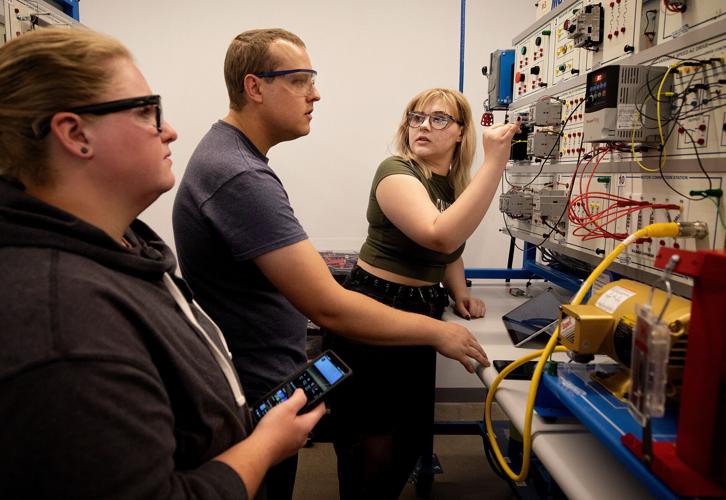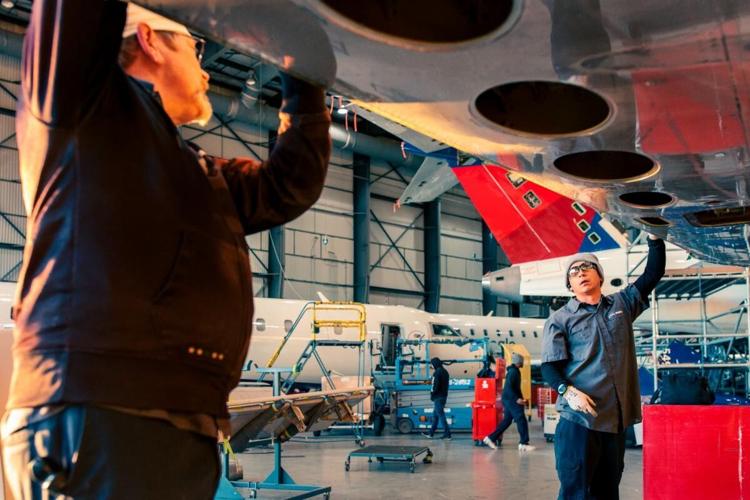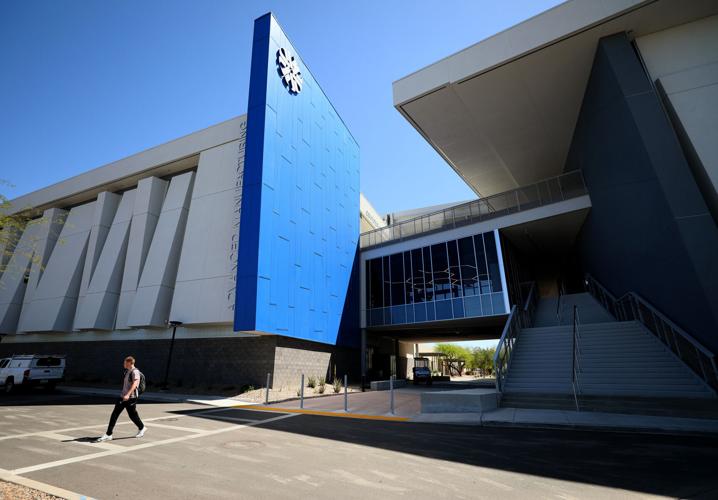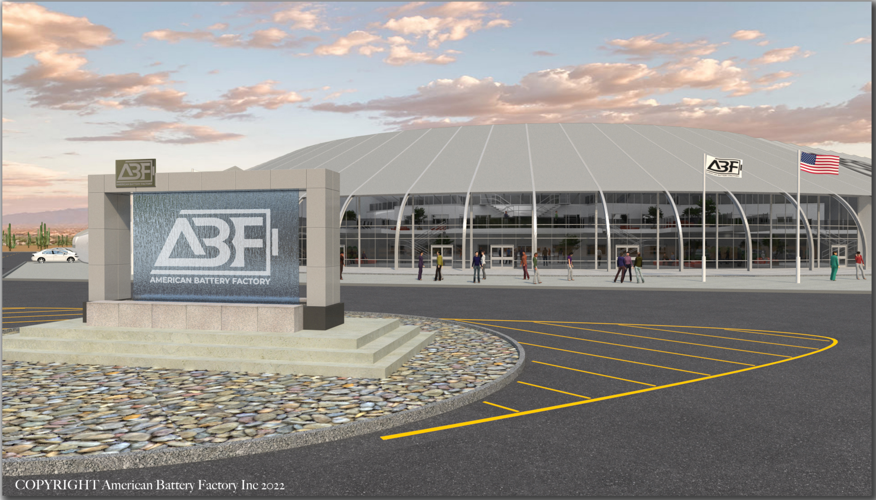Tucson’s economy has been on a roll in the past couple of years, regaining all the jobs it lost during the COVID-19 pandemic and posting healthy gains despite the strong odds many economists gave for a recession last year.
Now, the Tucson region is looking forward to hundreds of new jobs from growing local businesses, including big expansions at two local aviation-maintenance firms and new arrivals like startup American Battery Factory.

Montreal-based MHI RJ Aviation Group plans to add more than 250 jobs over three years to service regional jets at its Tucson airport facility.
But much like Arizona and the nation as a whole, the Tucson region faces future economic uncertainty amid familiar challenges: a tight labor market, high housing costs and stubbornly high inflation.
Recently revised data shows that in 2023, Tucson added about 6,100 jobs over 2022, for a growth rate of 1.6%, said George Hammond, director of the Economic and Business Research Center in the University of Arizona’s Eller College of Management.
That growth rate, revised upward from an initial estimate of 1.4%, was a bit better than the 1.2% job growth the UA research center had forecast last year.
But it’s also below the national average of 2.3% employment growth last year, the Arizona state average at 2.6%, and Phoenix at 3%, Hammond noted.
“Job growth has been solid not only in Arizona but nationally, the unemployment rate remains low and basically the economy has weathered the interest-rate increases engineered by the Fed much better than we thought it would,” Hammond said, referring to the Federal Reserve’s efforts to tame inflation through rate hikes.
And while economists a year ago predicted a good chance of a mild recession, that hasn’t materialized.
The chances of a recession have dropped this year according to most economists. Hammond continues to believe Tucson and Arizona would fare better than other regions during a nationwide recession.
According to Bankrate’s latest quarterly economists’ poll, the odds of the U.S. economy entering a recession within the next 12 months have fallen to a two-year low of 33% after reaching as high as 65% in 2022 and about 50% in the second half of 2023.
Income gains diminished by rampant inflation
Hammond said the odds now favor continued U.S. economic growth, but most recently, “the risks to that are tilted to the downside.”
“Inflation continues to exceed the Fed’s target, and there’s now fear that the Federal Reserve may keep interest rates higher for longer or may be forced to raise interest rates further,” he said.
Though inflation has moderated recently compared to 2022, price levels remain elevated in Arizona and across the nation, Hammond said.
From December 2019 to December 2023, the Phoenix metro area all-items consumer price index increased 24% while the national index rose 19.4%, according to the UA research center’s update in March.
And while personal income has risen significantly across Arizona since the start of the pandemic, rampant inflation has eaten up most of those gains, Hammond notes.
Before adjustment for inflation, the state’s per-capita personal income jumped 22.5% from 2019-22.
But, after adjustment for inflation using the Phoenix consumer price index, per capita personal income grew only 2.5%.
Tucson sees steep drop in home affordability
Related to inflation, a steep drop in local housing affordability — historically a strong selling point for Tucson — has stressed families and communities nationwide, Hammond said.
In the last quarter of 2019, right before the pandemic began, 71.2% of homes that were sold were affordable to a family making the local median income, making the Old Pueblo one of the lowest-cost housing markets in the West.
But for the last quarter of 2023, that home affordability in the Tucson area was down to 32.5%, below the national index of 37.4%.
Low home affordability can cause increased homelessness, reduce the amount of money consumers can spend on retail purchases and discourage people from migrating to an area, Hammond said.
Even so, Tucson housing remains more affordable than Phoenix, where the affordability index dropped to just 22.1% at the end of 2023 from 64.9% before the pandemic.
And Tucson remains a far more affordable place to buy a home than big cities like Los Angeles and San Diego, where the home affordability index is in the single digits, Hammond said, noting that California is the largest source of out-of-state migrants.
Substantial growth in manufacturing jobs

Rendering of the American Battery Factory planned for Tucson.
Post pandemic jobs recovery has remained uneven among industry sectors.
The only sectors in Tucson that lost jobs in 2023 were trade, transportation and utilities, which was down about 500 jobs; and financial activities, which dropped about 1,000 jobs.
While job growth in any sector is welcome, the Tucson area has seen more success in adding coveted manufacturing jobs in the past year than the state or Phoenix.
Manufacturing jobs are highly sought because of their relatively high pay, capital investment and outsized contribution to local economic output, comprising about 7% of the local workforce while contributing about 14% to the Tucson area’s gross domestic product in 2023.
Tucson added 1,300 manufacturing jobs between February 2023 and February 2024, while Phoenix and the state saw small net losses in manufacturing jobs.
Local manufacturers that added jobs in the past year include advanced battery maker Sion Power, which is adding 150 jobs in an expansion that includes an automated production line to make its proprietary lithium-metal batteries for electric vehicles.
More manufacturing jobs are coming.
The biggest local jobs announcement came in 2022, when Utah-based lithium-iron phosphate battery cell startup American Battery Factory said it would build a “gigafactory” complex and headquarters at Pima County’s Aerospace Research Park south of the airport that would initially employ about 300 workers and could scale up to more than 1,000 workers.
While the company ceremonially broke ground at the site last October, it only recently announced a partner to supply equipment for an automated production line, paving the way for a final design of the planned fabric-roofed plant.
American Battery Factory President John Kem said heavy earthmoving at the site is expected to start by late summer or fall.
“This partnership has allowed for the final design and initial production of customized machinery specifically built with our needs at the forefront,” American Battery Factory President John Kem said in a statement to the Star, noting that planning for the 1,500-foot-long facility was essential in determining foundation strength and planning utility infrastructure.
“We look forward to sharing more details as we continue to make this vision a reality for Tucson and the country,” Kem said.
Jim Ge, ABF’s CEO, said the battery startup’s equipment supplier is already working with Pima Community College to offer training in factory automation at the school’s new Advanced Manufacturing Building at the Downtown Campus. Partnering with the University of Arizona may also be in the cards.
“We are in talks with U of A about the possibility of utilizing their lab for testing,” Ge added. “They have some of the most advanced equipment in the country for battery testing.”
Pima students have been taking classes and getting hands-on experience in automation and other manufacturing technologies, including machining and welding, and optics at the new $35 million building, which opened to classes in August.

Eric Thomas demonstrates the use of a robotic arm at Pima Community College’s new Advanced Manufacturing Building.
The manufacturing tech building was the latest phase completed in a major makeover and expansion of Pima’s Center of Excellence in Applied Technology at the Downtown Campus.
Meanwhile, Colorado-based MicroStar Logistics plans to hire nearly 250 workers to warehouse and recondition stainless-steel beer kegs at a new, 270,000-square-foot industrial facility on Tucson’s southeast side, with completion expected this summer.
“I’m optimistic about the trend in manufacturing employment across the state including here in Tucson. So I think we are going to see pretty substantial growth and these tend to be relatively high paying jobs, as well,” the UA’s Hammond said.
Employment soars at local aircraft companies

Two 90,000-square-foot hangars being built by Ascent Aviation Services at Pinal Air Park are seen in this graphic rendering.
Meanwhile, two longtime local aircraft maintenance operations are adding hundreds of tech jobs as part of significant expansions.
Montreal-based MHI RJ Aviation Group, a maintenance, repair and overhaul services provider that acquired the Tucson maintenance operation for Bombardier’s CRJ line of regional jets in 2020, says it plans to add service lines and 250 jobs at its facility at Tucson International Airport over the next three years, including about 100 this year, on top of a current workforce of about 400.
And Ascent Aviation Services announced last October that it would add some 300 employees to staff two new hangars at its Marana Aerospace operation at Pinal Airpark to handle passenger-to-freight airliner conversion under a 15-year contract with an Israeli company.
Both aircraft-maintenance companies are counting on getting more technicians from PCC’s acclaimed Aviation Technology program, which doubled its capacity at TIA last year with completion of a new hangar and classroom facility.
Small businesses grow despite challenges
Tucson has also seen healthy gains in small-business growth since the pandemic, with the number of new business establishments rising from 5.8% in 2021 to 8.2% — third among the city’s Western peer cities behind only Phoenix and Salt Lake City.
Michael Guymon, president of the Tucson Metro Chamber of Commerce, said the growth in businesses is positive, but government jobs still dominate too much of the local economy.
In 2023, 19% of jobs in the Tucson metro area were in government — the largest industry share of local employment — compared with about 13% statewide and 14.4% nationally.
“A lot of the success over the past couple of years has really been in and around manufacturing — we’re seeing some great gains in that,” Guymon said. “But we’re also still very much a a government town and we don’t really gain a whole lot of GDP from government jobs. So, we still have some work to do to address the industry mix that exists here in Tucson.”
Tucson’s smaller businesses, including retail stores and restaurants, are facing their own challenges, Guymon said.
Local restaurants, the linchpin of Tucson’s status as a UNESCO City of Gastronomy and a key part of the small business community, continue to struggle with hiring, high labor cost and inflation, he said.
“They’re really struggling with these labor issues and these increased food costs that are forcing them to increase some of their (prices), but they have to be careful about increasing it too much so that they start alienating customers or customers aren’t willing as much anymore to go out to eat,” Guymon said.
Tucson businesses also have seen a post-pandemic surge in retail theft that prompted the Chamber to revive a task force to address the problem, while many small businesses cope with safety and security issues related to homelessness.
Guymon said one Chamber member recently said she plans to move her longtime retail store out of the city to Marana or Oro Valley due to spiraling costs for security measures to deal with vagrants around her business.
Check out the advanced battery-cell plant American Battery Factory plans to build starting in 2023, south of the Tucson airport.










